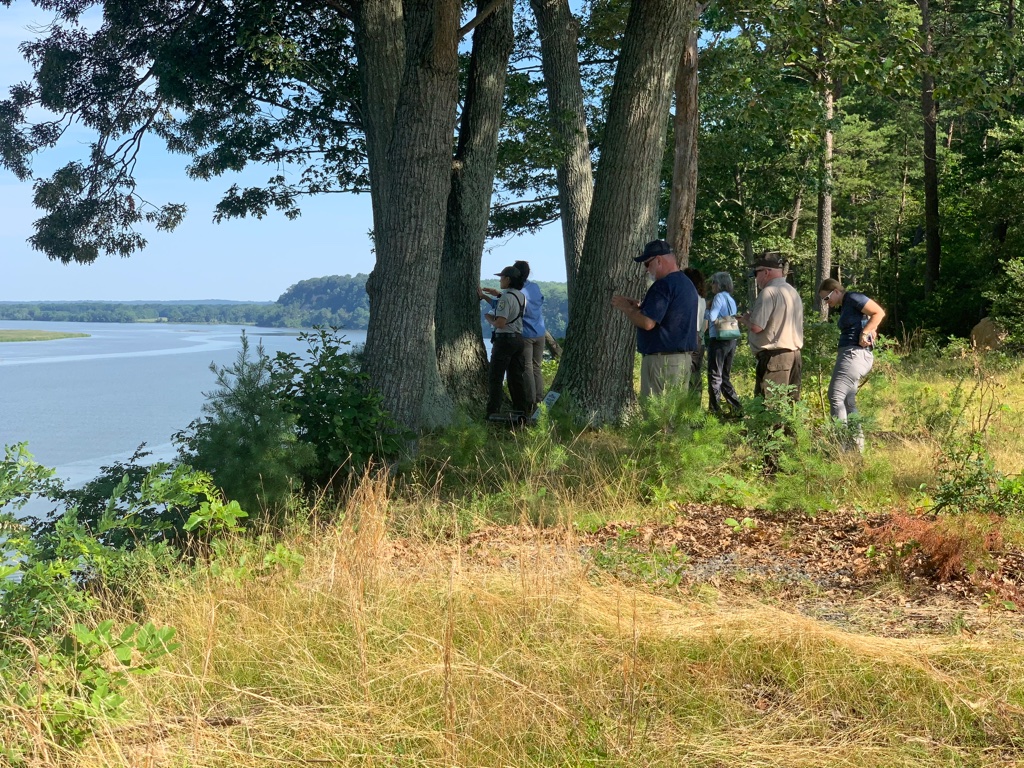Want to see a spectacular view of the Rappahannock River from Fones Cliffs before the property is open to the public? Join the Rappahannock Wildlife Refuge Friends to help plant trees on Thursday, Sept. 28 or Saturday, Oct. 7. This is a two-day event. Sign up for either day or both days. The plan is to plant 70 trees, coming courtesy of the Friends of the Rappahannock.
For those who may not remember, Fones Cliffs is a spectacular four-mile-long set of 100-foot-high, forested sandstone bluffs along the Rappahannock above Tappahannock. They’re interspersed with ravines that drain rainwater from them. Together, the cliffs and ravines are home to a large population of resident and migrant bald eagles and the historic epicenter of Virginia’s Rappahannock Tribe. Captain John Smith mapped three tribal villages along the Cliffs during his exploration of the Rappahannock in August 1608, including one on the property where this planting will occur.
Because of their wildlife and historical value, Fones Cliffs have been a high-value target for conservation for years. In 2015-2022, however, the previous owners of the Cliffs threatened to develop the area into a hotel/golf course/residential community. During this controversial period, they cleared a 13-acre riverside parcel illegally, with the result that the adjacent portion of the Cliffs collapsed into the river, resulting in a criminal citation and the levying of a hefty fine.
Since then, a broad-based effort with local, regional, and national partners has finally succeeded in conserving the entire length of the Cliffs over the past several years.
The property where the Refuge Friends planting will take place lies in the center portion of the Cliffs. It’s now the Fones Cliffs Unit of the Rappahannock River Valley National Wildlife Refuge, which is flanked by sections of the Cliffs lying immediately up- and downriver, which the Rappahannock Tribe owns, with conservation easements held by the U.S. Fish & Wildlife Service.
The Refuge and the Tribe plan to open Fones Cliffs to the public in time, on a controlled basis while restoring habitat. Though parts of the property were cleared in the past for agriculture and timber, “this landscape seems like it wants to be a forest,” Joe McCauley told Bay Bulletin. “Now we have an opportunity to reforest it carefully.” McCauley, a now-retired former Manager of the Rappahannock Refuge, has been deeply involved in the effort to conserve the Cliffs as a consultant to the Chesapeake Conservancy.
On the first planting day, volunteers led by the Friends with assistance from the Refuge’s staff will dig holes in specified spots near the cliffs’ edge, sifting dirt as they go, to search for artifacts and other items of interest. The second planting day will include any sifting that was not completed, and then planting the trees. According to Smith, this property held one of the villages. The purpose of the planting is to hold soil and provide habitat while still providing visitors the view without walking to edge, where the soil is fragile. The Friends of the Rappahannock and its partners plant hundreds of thousands of trees as part of the Rappahannock Coastal Forest Program, including these.
“The work done is really valuable to the Rappahannock Refuge,” McCauley concluded. “I think plantings like this are great opportunities to invite people to join them.”
-John Page Williams




